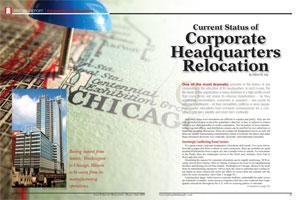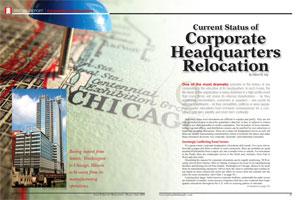

High-Stakes Game
One of the most dramatic episodes in the history of any corporation is the relocation of its headquarters. In such moves, the life-blood of theorganization is being disturbed in a high profile event that many times will shake its internal stakeholders – be they employees, stockholders, customers or suppliers – and puzzle its external constituents – be they competitors, politicos or news people. Headquarter relocations have immense consequences for a company’s long-term identity and short-term continuity.
And many times such relocations are difficult to explain and justify. They are not only grounded in easy-to-describe quantitative data but, in fact, in subjective criteria which is not often amenable to simple explanation. The relocation of most manufacturing, regional offices, and distribution centers can be justified by cost reductions or improved operating efficiencies. These are in place for headquarters moves as well, but there are usually transcending considerations which overwhelm the basics and make these relocation decisions very corporate “personal” and leadership concentric.
Seemingly Conflicting Trend Factors
To a great extent, corporate headquarter relocations defy trends. For every relocation into a major city from a suburb or rural community, there are probably an equal number of relocations from a major city into a smaller town or suburb. For relocations to the South, there are counterpart moves to the North and, similarly, from East to West and vice versa.
Discerning the reasons for corporate relocations can be equally perplexing. NCR recently moved from Dayton, Ohio, to Atlanta, Georgia, to be closer to its manufacturing facilities and Boeing moved from Seattle, Washington, to Chicago, Illinois, to be away from its manufacturing operations. Moves from the cities to suburban and exurban areas based on more relaxed life styles are offset by moves from the suburbs into the cities for more excitement.
Copying their larger, better-known corporate brethren, underneath the radar screen are hundreds of smaller, lesser-known companies that have also scattered their headquarter relocations throughout the U.S. with no seeming pattern or rationale.
Making Sense of It All
It’s rare when only a single deficiency leads to a relocation or a single specific event triggers a move. Most often it is a number of issues and incremental changes that trip the final relocation decision.
Having an objective observer provide counsel on your relocation options and likely outcomes can help you determine the costs, benefits and risks. If the benefits outweigh the expected costs and risks, the leadership of the corporation must be convinced that the strategic and long term interests of the company are best served in a new location and that the corporation will accept the costs as an investment in its long-term future.
Changing Assumptions about Costs
Over the years, it has been taken as fact that any headquarter relocation will have a major negative impact on the corporate bottom line. Depending on the specific situation, this can no longer be assumed. Recent relocation projects undertaken by Ady International Company indicate that not only can costs be minimized, but savings can be achieved.
What has happened in recent years has tended to balance the relocation cost equation. The degree of sophistication by companies in implementing the move along with the use of professional relocation services has resulted in much smoother, more cost-effective and speedier relocations. In addition, one of the largest cost equalizers has been the willingness of receiving communities and receiving states to provide financial assistance to relocating corporation headquarters. Chief among these are direct cash incentives to cover all or part of any employee relocation costs. These are given in recognition of the quality of the jobs being created and the prestige and publicity generated by the newly located company.
“Why?” is the Question
Cost savings alone are not usually enough to prompt a relocation decision. So what drives corporations to relocate their headquarters? What are their objectives? If not exclusively cost reduction, what? If you dig deeper than simply WHERE they relocated from and to, are there discernable reasons as to WHY? The answer is “yes” and they can be divided into “internal drivers” and “external drivers.” “External drivers” are those factors that relate to the existing geographical placement of the facility and “Internal drivers” are those factors that relate to the internal operations of the company.
Key External Drivers of Corporate Headquarter Relocations
Simply stated, the existing location no longer meets the company’s current or future operational requirements. They literally “push” the company from the existing location. This can be for a number of reasons:
Inability to Hire from Distant Labor Markets
The needs of the company must be continually nourished by new talent, be it from nearby labor markets, or remote U.S. and international labor markets. Key positionsin the company that remain unfilled or difficult to fill can be a harbinger of the existing location’s inability to meet the rigid requirements of tomorrow’s leaders.
Employee Transfer Refusals
A most telling issue is when existing employees refuse transfer to the headquarters location regardless of corporate promises. This is usually a function of real or perceived excessive living costs at the existing headquarters location or lack of personal development opportunities in headquarters city.
Undeveloped Local Infrastructure
Depending upon the corporation, the existing community must possess a business community with access to banks/investment firms, law firms, cultural amenities, prestige colleges and universities, and spousal employment opportunities. In today’s environment these are all necessary to attract and retain employees and remain competitive.
Inadequate Domestic and International Air Service
Over the years, many companies have transitioned from a local firm to a national or international corporation requiring accessibility to remote customers, governments, investors and others. If the existing community airport boasts only regional carriers with limited inbound and outbound flights, this can be a red flag to corporate competitiveness.
Inhospitable Business Climate
When local and state laws, rules and regulations become too overbearing to operate an effective organization, it’s a corporate profitability danger signal. These might include taxes, inspections or various restrictions. As these become more and more onerous, the existing location becomes less and less attractive.
Unfavorable Community Image
The image of a community reflects the image of the corporation. Unprogressive, population-losing, crime ridden, filthy-looking, under-achieving students, and uncaring leadership leads to many corporate re-evaluation scenarios. How can a company hope to create or maintain its positive image with an external environment fraught with negative characteristics?
Lack of Expansion/Consolidation Space
Finally, the lack of, or the excess of, physical space may prompt relocation. Through downsizing and out sourcing, many companies have excess space in expensive environments. Alternatively, many fast-growing companies lack contiguous space in which to expand. Communities without online space may be the trigger to corporate consideration of relocation.
Key Internal Drivers of Corporate Headquarter Relocations
In most cases, the “internal” factors represent the most important determinants for corporate headquarters relocation. These factors, internal to the company, include its organization, operation, leadership and its vision for the future. Many reasons prompt the internal “pull.”
Mergers and Acquisitions
In major M&A projects, there will be two headquarters that will need to merge, eventually, into one. Frequently, justification of an M & A is cost reduction through consolidation. Such consolidation is usually to one of the existing headquarters locations, since the challenges of moving to a new location would be doubled.
Organizational Restructuring
The combination of the decoupling of modules within an existing organization and the benefits of outsourcing, can result in a new “elite” headquarters, with stand alone administrative offices and other functions a half continent away. The low-cost digital network reduces the need for geographic proximity and allows for significant savings from the former configuration. Such a restructuring drives the “where” question for the reconfigured headquarter operation.
Cultural Change
A unique, but important driver of headquarters relocations is the need for cultural change within the organization. Many corporations have acquired, over the years, a massive, concentrated bureaucratic structure that saps their dynamic vitality to respond to current business exigencies. These companies believe that the only opportunity to revitalize the company is to relocate to another area where they can grow the “new” culture.
New Leadership
New board members or a new CEO respect a company’s history but, even so, many times ask the simple question, “Why is our headquarters here?” The newcomers frequently see locational failings that long time board members and executives don’t see. Because the company started here or has been here for a very long time begs the question. To prevent initial consideration of a relocation scenario, substantive answers must be forthcoming from present management.
Image and Branding
Aside from the community image is the desire for the corporation to change its own external image. For many companies, the key driver is to reposition itself in the marketplace with a new identity, and one part of establishing that new identity is to move to a new location.
Missteps to Avoid
The factors driving a relocation are a complex mix of multiple drivers, viewed through the context of your industry, the competition you face now and in the future, and how you plan to compete over the long term. Those drivers are a combination of factors – internal and external, quantitative and qualitative. And to make it more complicated, deciding to move a corporate headquarters is likely a decision that comes up only a few times in one’s corporate career.
Going it Alone
Itis very rare that a corporation will attempt to evaluate and implement a headquarters relocation without outside professional assistance. Deciding whether to relocate your headquarters is a high-risk decision with the potential to raise your company’s fortunes or sink them before it even begins. Experts can conduct virtually the entire assessment without revealing your company’s identity; they are experienced at finding out about and negotiating incentives packages; they have access to specialized databases that greatly assist with the evaluation process; they are used to the tight timelines that corporations require; this is their “day job” so you don’t have to worry pulling internal executives away from their key roles for any length of time while the project is underway.
Neglecting Continuity
Many approaches and techniques have been implemented over the years to maintain continuity during the relocation process. Few have been completely successful. “Stay bonuses” and generous severances help, as does professional relocation assistance, but when top management is dealing with locational change along with its other responsibilities, it’s difficult to avoid distractions on the rest of the organization. These distractions affect both the cost of relocation and the time required to implement the relocation. Usually, an inflated timeline for relocation creates confidentiality issues and internal management issues. Make sure to develop an internal and external communications plan.
Thinking Short Term
Many times a single event, such as a major tax increase or a new CEO, can trigger a presumptive relocation exercise. If relocation is only a short term fix devoid of any deliberate analysis of its long term strategic implications for the company, it could have profound negative implications for the company far into its future.
Undervaluing the Importance of Confidentiality
One of the more difficult aspects associated with corporate relocation is maintaining confidentiality during the process until the most precipitous time for disclosure. Premature disclosure can adversely affect employees, stock holders, customers, politicians and service providers. As a result, companies must initiate the discussion of a potential relocation with the smallest possible team under the strictest of external and internal confidentiality. These are usually executives at the highest levels within an organization.
Focusing on Incentives
Companies can get blindsided by incentives. If a location is not right for the corporation, no level of incentives will make it right. Make sure all the qualitative and quantitative factors associated with potential new locations are positive and then use incentives as a tie breaker among the finalist locations.
Using a Snapshot Approach to Community Evaluation
In most cases, corporate site seekers evaluate locations as they appear during the relocation timeframe. This can provide a very distorted picture of the community based on current information not indicativeof its past history, or more importantly, its future potential. Since the relocated headquarters will be operating into the future, it is imperative that the community be evaluated on its ability to satisfy both the short term and long term objectives of the company. Remember, many communities that had very low unemployment rates a few years ago now have a plentiful labor supply. Based on its past history, will that last into the future?
Conclusion
Even though corporate headquarter relocations are not a daily event, sooner or later virtually every corporation will confront this issue. It may be an informal discussion within the C-suite, it may be a feasibility analysis undertaken by a site consultant, or it may be a full blown project with the ultimate intention of relocation. Whatever the degree of commitment to the relocation, sooner or later, it will be an important item on management’s agenda.
There is no “pat answer” to whether you should relocate, and if so, to what location. Getting to the right answer involves introspection, analyses, and ultimately, good judgment. Professional site selectors can guide you through the process to help ensure that these important decisions are made with your company’s long-term best interests in mind.

